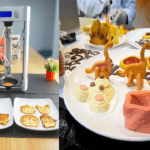Food robotics represents a transformative technology in the food industry, offering innovative solutions that streamline production, enhance efficiency, and improve quality. By integrating robotics into food production processes, businesses can achieve greater precision, reduce labor costs, and ensure consistent product quality. This guide explores the key aspects of food robotics, including its benefits, applications, challenges, and future trends.
What is Food Robotics?
Food robotics involves the use of robotic systems and automation technologies to perform various tasks in the food production process. This includes handling, processing, packaging, and quality control of food products. Robotics in the food industry can range from simple automated systems to complex robots equipped with advanced sensors and artificial intelligence.
Benefits of Food Robotics
- Enhanced Efficiency and Productivity
- Increased Output: Robotics can operate continuously without breaks, leading to higher production rates and consistent output.
- Reduced Production Time: Automation speeds up processes such as sorting, packing, and labeling, minimizing time from production to distribution.
- Improved Precision and Consistency
- Accurate Measurements: Robots can perform tasks with high precision, ensuring consistent portion sizes and product quality.
- Reduced Human Error: Automation minimizes the risk of errors associated with manual labor, resulting in fewer defects and higher-quality products.
- Cost Savings
- Labor Costs: Reducing reliance on human labor can lower operational costs and address labor shortages.
- Waste Reduction: Robotics can improve accuracy in ingredient handling and processing, reducing waste and optimizing resource use.
- Enhanced Safety
- Minimized Human Contact: Robots handle hazardous tasks, such as handling hot or sharp objects, reducing the risk of injuries.
- Sanitation: Automated systems can be designed to meet stringent hygiene standards, ensuring cleaner production environments.
- Scalability
- Flexible Adaptation: Robotics can be scaled up or down based on production needs, making it easier for businesses to adapt to changing demands.
Applications of Food Robotics
- Sorting and Grading
- Automated Sorting: Robots equipped with vision systems can sort and grade food products based on size, shape, and quality.
- Quality Control: Advanced sensors can detect defects or contaminants, ensuring only high-quality products are processed.
- Packaging
- Packing Lines: Robots can handle various packaging tasks, including filling, sealing, and labeling, with high speed and accuracy.
- Flexible Packaging: Robotic systems can accommodate different packaging formats, such as cartons, trays, and bags.
- Processing
- Cutting and Slicing: Robots can perform precise cutting and slicing of food items, such as fruits, vegetables, and meats.
- Mixing and Cooking: Automated systems can manage mixing ingredients and cooking processes, ensuring consistent results.
- Material Handling
- Palletizing: Robots can automate the stacking of products onto pallets, optimizing warehouse operations.
- Transporting: Automated guided vehicles (AGVs) and conveyors can move products between different stages of production.
- Inspection and Quality Assurance
- Vision Systems: Robots equipped with cameras and sensors can inspect food products for quality and compliance with specifications.
- Data Analysis: Robotics can integrate with data systems to analyze production metrics and identify areas for improvement.
Challenges of Food Robotics
- High Initial Costs
- Investment: The initial investment in robotic systems can be substantial, including costs for equipment, installation, and training.
- ROI Considerations: Businesses must carefully evaluate the return on investment and long-term benefits of robotics.
- Integration with Existing Systems
- Compatibility: Integrating robotics with existing production systems and workflows can be complex and may require significant adjustments.
- Customization: Tailoring robotic systems to specific production needs may involve additional costs and time.
- Maintenance and Support
- Technical Expertise: Maintaining and troubleshooting robotic systems requires specialized technical knowledge and support.
- Downtime: Unplanned maintenance or technical issues can lead to production downtime and impact efficiency.
- Regulatory Compliance
- Safety Standards: Robotics must comply with industry safety standards and regulations, which can vary by region and application.
- Hygiene Requirements: Food processing robots must meet stringent hygiene and sanitation requirements to ensure food safety.
- Skill Requirements
- Training: Employees must be trained to operate and maintain robotic systems, which may require upskilling and ongoing education.
Future Trends in Food Robotics
- Artificial Intelligence and Machine Learning
- Smart Robots: AI and machine learning can enhance robotic capabilities, enabling systems to learn from data, adapt to new tasks, and optimize performance.
- Predictive Maintenance: AI can predict potential issues and schedule maintenance, reducing downtime and improving reliability.
- Collaborative Robots (Cobots)
- Human-Robot Collaboration: Cobots are designed to work alongside human operators, enhancing flexibility and productivity in food production environments.
- Ease of Use: Cobots are typically easier to program and integrate, making them accessible for smaller businesses.
- Advanced Sensors and Vision Systems
- Enhanced Detection: New sensor technologies and vision systems improve the accuracy of inspections, sorting, and quality control.
- Real-Time Monitoring: Advanced sensors enable real-time monitoring of production processes, providing valuable data for optimization.
- Sustainability
- Eco-Friendly Solutions: Robotics can contribute to sustainability by optimizing resource use, reducing waste, and minimizing energy consumption.
- Green Technologies: The development of eco-friendly materials and energy-efficient systems supports environmentally responsible practices.
- Customization and Flexibility
- Adaptable Systems: Future robotic systems will offer greater customization and flexibility, allowing businesses to quickly adapt to new products and market demands.
- Modular Design: Modular robotic systems can be easily reconfigured to handle different tasks, enhancing versatility.
Conclusion
Food robotics is revolutionizing the food industry by enhancing efficiency, precision, and safety in production processes. While the technology presents challenges such as high initial costs and integration complexities, its benefits in terms of productivity, cost savings, and quality assurance are significant. As advancements continue in artificial intelligence, collaborative robots, and sensor technologies, food robotics will play an increasingly crucial role in shaping the future of food production. Embracing these innovations can help businesses stay competitive, meet consumer demands, and drive growth in an evolving market.



